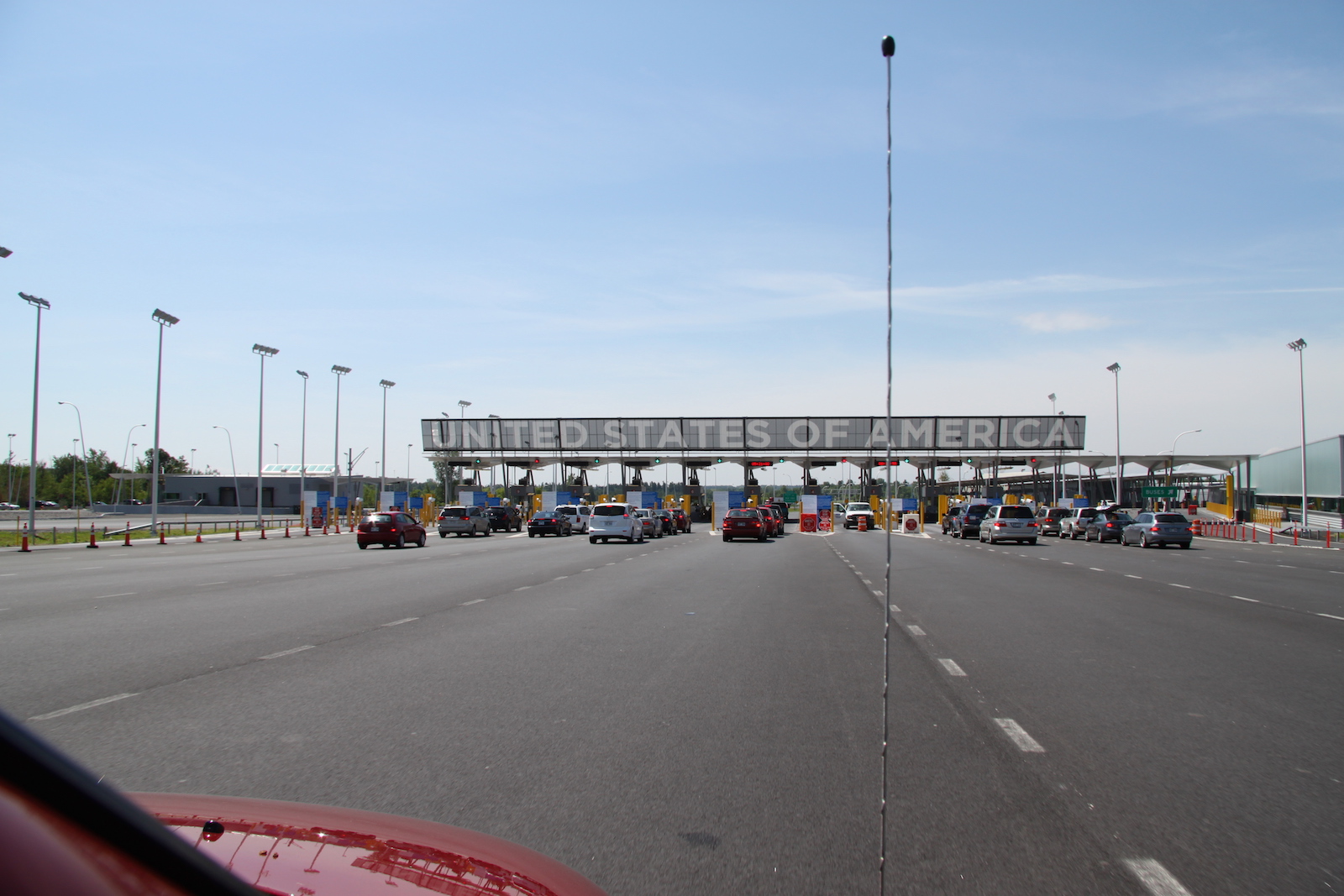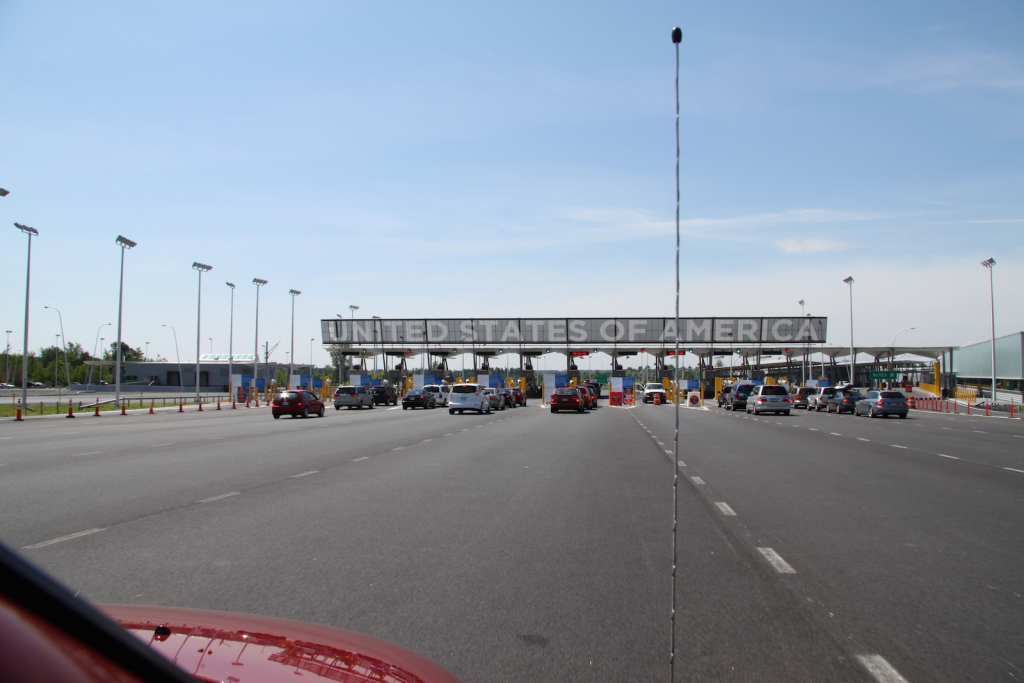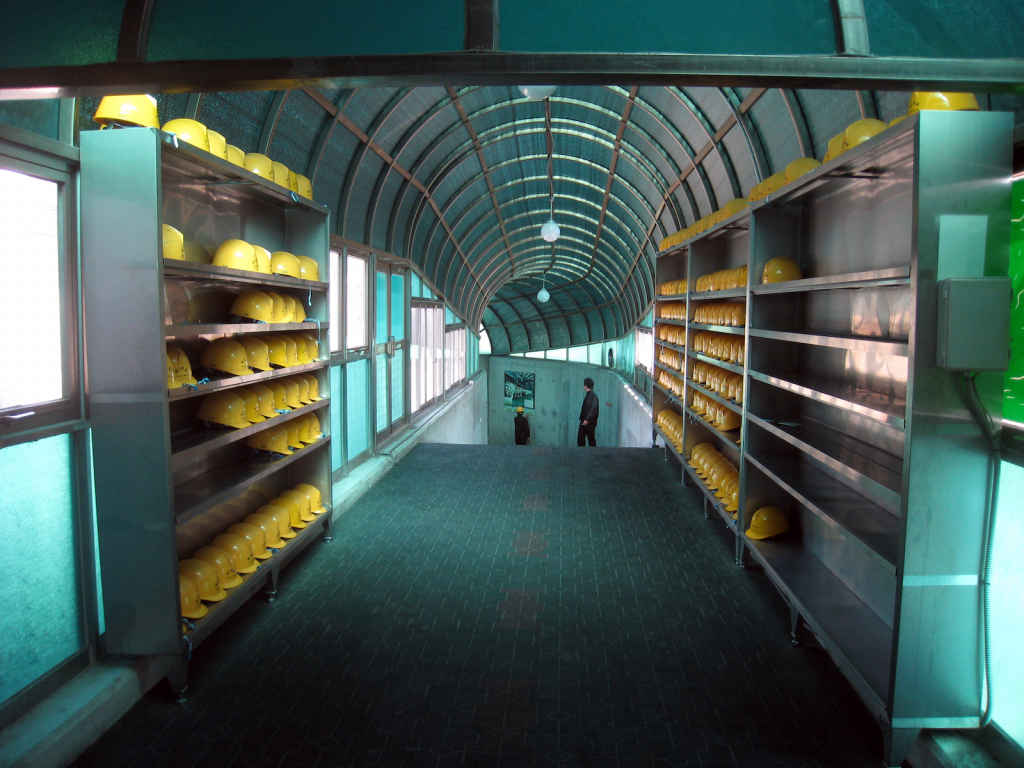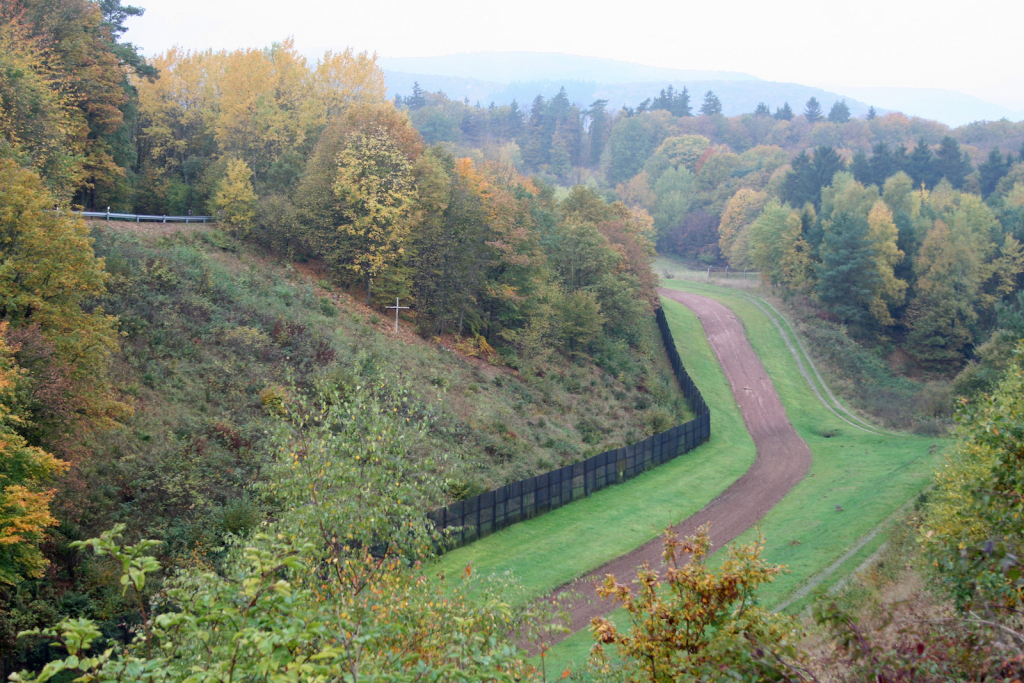Borders 101
NATURAL BORDER
The natural border is the only true border, indisputable, absolute. The others are only imitations, human constructions unable to equal natural perfection.
THE CLOSEST BORDER
The border closest to me is the one that separates us from the United States. The Champlain – St-Bernard de Lacolle border crossing is located on Interstate 87 and is used by people travelling between Montreal and New York, as well as Montrealers needing to do a “flagpole”—a fictitious exit and a real re-entry into Canadian territory to validate their immigration papers. However, this border crossing—one of the most important ones between Canada and the United States—has a particularly bad reputation, so it may be better to flagpole somewhere else.
From a distance, one first notices the words UNITED STATES OF AMERICA, written in enormous capital letters on the structure towering above the crossing point. Drivers often endure a long wait in their vehicles before being questioned by an officer, then sent to the adjacent building to obtain the I-94 form after an even longer wait. At regular intervals, a bus arrives, and the passengers—given priority but treated without consideration—must stand in line, crammed into a badly lit corner. A dozen officers, busying themselves with something else, make a point of ignoring everyone, bus passengers and drivers alike. During one of my visits, the officers, looking imperious, were all gathered around a worker who was ineptly trying to pass a braid of cables through the twists and turns of the ceiling. The show entertained them so much that they had obviously forgotten the reason they were there.
From time to time, one of the officers walks over to the basket containing the passports of waiting travellers, examines and weighs them up, estimates the profiles of the customers and the amount of work required, then wearily drops them back into the pile or, sometimes, takes one or two and, without conviction, calls their bearers’ names. When the indiscrete questions and the fingerprinting are finally over, you get back on the road having lost two hours and $6 per person, children included.
During my initial crossings, I always got the same officer at the first control booth. He looked more like a hipster than an officer; perhaps he’d failed in Williamsburg and come back to Plattsburgh, his birthplace, to find a stable job in border enforcement… He was extremely suspicious, cynical and sardonic with his questions. One, in particular, struck me with its sharp sense of rhetoric: “Are you on holidays or are you taking time off?”
BORDER CROSSING
The border crossing represents the stage on which the drama of passing from one national space to another gets played out. While small border crossings involve nothing more than a simple roadside shack and a striped barrier, large ones proudly boast decidedly symbolic architecture, generally in the form of a more or less majestic arch. Whether in a classical, ethnic, modernist or kitsch version, the arch announces the border, protects the crossing, ensures border enforcement, and expresses the grandeur and generosity of the country without offending its neighbour.
IMPASSABLE BORDER
While borders are generally meant to be crossed at certain points and under certain conditions, some, however, are completely hermetic, with no single crossing point. For example, Cyprus, the border between Israel and Lebanon, and the Korean Demilitarized Zone are all hermetically closed and include a “no man’s land” that the United Nations manages. But in fact, no border can be perfectly hermetic, hence the tunnels in Korea and Gaza.
DEMATERIALIZED BORDER
Mass air travel has dematerialized territories and the borders along with them. It all happens in the non-place of the airport, a space of globalized transit, quintessentially abstract. At least superficially, since every airport also has its hidden spaces: spaces of control and interrogation, of holding and detention. These invisible spaces are nevertheless there; sporadically, they become visible, for example when an illegal immigrant is being deported on a scheduled flight. Yet once in the air, there is no border, we don’t experience the crossing from one national territory to another. All that we are left with of the passage is the customs control and the duty-free store.
EXTERNALIZED BORDER
To avoid handling the deportation of undesirables and bearing the burden of related costs, some countries try to relocate border controls to the source: they operate at the points of departure rather than arrival. It is a managerial fact that has been bolstered by security arguments since 9-11.
INTERNAL EUROPEAN BORDERS
As a child, I lived a few hundred metres from a border and I remember going almost daily with my father to do the shopping on the other side, where life was apparently cheaper. The border officers became acquaintances who greeted us warmly and never checked us. Even so, I dreaded every crossing and I always feared we would be arrested, as though the apparatus of the border was enough to make me feel guilty.
Later, as a teenager, I travelled regularly between one parent in Paris and the other in Stuttgart (the train trip took 7 hours in the 1970s and still takes 7 hours today). In Strasburg, German officers—green uniforms and German shepherds—would board the train and methodically check all the passengers. On the way back, it would be the French—navy-blue uniforms and no canine unit—who would board at Kehl and proceed in a less systematic manner. Conducting the identity verification by walkie-talkies took some time. Occasionally, someone had to get off the train. I don’t remember ever witnessing a violent scene, it all happened quietly, at least in my memory.
Today, these internal European borders have disappeared. Sometimes, the landscape bears traces of their existence, but most of the time, these traces have completely vanished. In fact, they have been moved to the external borders of Europe, to offer single-window access to all the space they contain.
CLANDESTINE CROSSING
In the 1990s, I worked as a sleeping-car attendant for the Compagnie Internationale des Wagons-Lits. I was based in Paris and assigned to night trains to Italy, Spain, Austria, and Denmark. It was an ideal job for an artist, although the railway subculture was hardly appealing: a macho world, racist, poorly educated, with right-wing politics and a love of easy money.
Every time I came back from Italy, men would accost me at the Turin train station and offer me money to smuggle them into France. One day, arriving in Paris after a long trip, I witnessed the police dismantle the ceiling of my car and pull out six men. They looked resigned to their fate, hardly surprised. I hadn’t noticed anything; they must have hidden there before I came on duty in Pisa. They had spent over 15 hours above my head, in “my” car, without me realizing it.
The only training my employer had given me consisted in citing the Penal Code in my work contract, in particular the penalty for aiding an illegal entry into national territory. In my handsome, Balenciaga designed royal blue uniform, I was both a cog in the repressive machine and a suspect of human trafficking. It thus was a relief when I learned that my work contract was not being renewed.
BORDER AND WALL
The no man’s land of the Berlin Wall was so narrow in some spots that in summer you could hear the people on the other side speaking through their open windows. Yet the wall didn’t exactly correspond to the border; it was built on GDR territory, set back from the border. And in some areas, the status of certain isolated lots was very complicated, forcing both Germanys to negotiate and trade lots along the wall. This was the case with the famous Lenné Triangle, a sort of Occupy encampment twenty years before Zuccotti Park and the site of numerous protests, most notably the only instance on record of West Germans fleeing to the East—180 activists who were escorted back to the West the following day.
SHTARKER LOGIC
Today, Israel is the one to take up the method of building a wall before or, in this case, beyond the border. By building its “separation barrier” far beyond the border, Israel didn’t saddle itself with the same reservations as the GDR. Here, shtarker logic prevails, which maintains that a border is worthless unless rendered into a wall. In reality, the protection of Israelis, as legitimate as it might be, is only a false pretext for plundering territory.
INNER GERMAN BORDER (1945-1989)
I remember being pulled over on the transit route between West Berlin and Hamburg one cold and rainy night in November or December 1987. The East and the West co-existed along this highway, a sort of no man’s land stretching over 250 km that had to be crossed to reach West Berlin from the FRG. This transit route was a popular hunting ground for the VoPos (the GDR police), who could easily extort money from West Germans in their fancy sedans and other fools unfortunate enough to venture there.
The policemen who had pulled me over spoke with an incomprehensible Saxon accent and were absolutely, deadly serious. They locked me in a cell, regularly taking me out to be interrogated. The interrogations proceeded like in the movies, with a blinding lamp pointed right at me and the same questions repeated over and over: What is the purpose of your trip? Where do you live? Who did you meet? Who do you know in the GDR? Do you have any banned goods? And so on. After each interrogation, I would be taken back to the cell, and then the cycle would begin again. When the night was over and they had had enough, they set the fine at the amount of money I had on me (50 DM) and let me leave with just enough gas to reach Hamburg.
DEMARCATION LINE (FRANCE, 1940-1943)
In 1942, my grandparents decided the time had come to attempt crossing into the free zone. Aryan friends who owned a moving truck helped them. First, they hid their two daughters, who managed to reach the free zone. When their turn came a few days later, they got caught. They were transferred to Drancy and spent one year there before being deported to Auschwitz via Convoy #57, on July 18, 1943.
BORDER AS WEAPON
Qalandia, located between Ramallah and Jerusalem, is the main checkpoint between the West Bank and Israel. It is the cruellest border crossing I know, in which the aim is clearly to humiliate, demoralize and dehumanize the Palestinians. The checkpoint, intended only for Palestinians needing to cross into Israel, is designed in such a way that the “travellers” feel like animals arriving at the slaughterhouse. They advance through a maze of metal fences, concrete blocks and control points concealed behind tinted windows. Soldiers, often out of sight, bark orders in Hebrew through loudspeakers: move on, step back, stop, clear out, empty your pockets! Qalandia is an excellent indicator of the occupation’s brutal reality. Here, the border is not just the demarcation between two territories, it is also a weapon deliberately used in armed conflict.
STRADDLING THE BORDER
From the perspective of capitalism, the border is an obstacle to the flow of goods and capital. Thus, the EuroAirport Basel–Mulhouse-Freiburg seems to simply ignore the fact that Basel, Mulhouse, and Freiburg are located in three different countries. As for the Tijuana Cross-border Terminal, which is supposed to open this year, it literally straddles the border. This airport terminal, accessible from both Tijuana and San Diego, acknowledges the existence of the border, but more importantly the need to transgress it. The market and the state don’t share the same interests.
BORDER FANTASY
The border is above all a mental construct, a fantasy as old as the world itself. It is also an epistemological question: How does change work, how does one cross from A to B? Just look at the success of the Broen/Bron TV series, a Danish-Swedish co-production created, written and played in both Danish and Swedish, in which the story begins with a corpse found on the Øresund Bridge—which connects Sweden and Denmark—lying exactly over the border line. The series was such a hit that variations soon followed: an American version situated between El Paso and Ciudad Juárez, as well as a Franco-British version, in which the corpse is found in the Channel Tunnel, halfway between France and Britain. These series attest to the fascination exerted by the border’s exact location, the demarcation point telling us that without our knowing, we are already on the other side.
Translated by Oana Avasilichioaei
Michael Blum is an artist based in Montreal since 2010. His projects include A Tribute to Safiye Behar, a museum dedicated to the secret lover of Mustafa Kemal Atatürk (9th Istanbul Biennial, 2005), Cape Town – Stockholm (On Thembo Mjobo), a book and a radio play investigating the complex relationship between Sweden and South Africa (Mobile Art Production, Stockholm, 2007), Exodus 2048, which staged a possible future in the Middle East (Van Abbemuseum, Eindhoven, 2008, New Museum, New York, 2009), and Palazzo Chupi, a reflection on the convergence of art and real estate (Optica, Montreal, 2015). He is a Professor at Ecole des arts visuels et médiatiques, UQAM, Montreal. www.blumology.net










